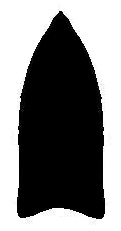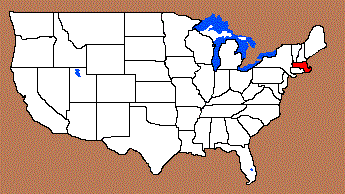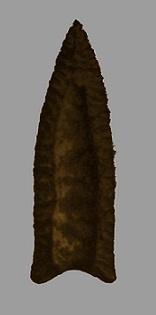Outline is Representative of Size and Shape:


Name Details:
Identified By: Douglas S. Byers
Named For: Type Site
Date Identified: 1954
Type Site: Bull Brook site, Ipswich, Massachusetts
Identified By: Douglas S. Byers
Named For: Type Site
Date Identified: 1954
Type Site: Bull Brook site, Ipswich, Massachusetts
Point Validity:
Valid type
Bryers was a distinguished anthropologist who served as Director for the Peabody Museum for over 30 years. This type was named in a professional publication and has many professional references. This is considered a valid type
Bryers was a distinguished anthropologist who served as Director for the Peabody Museum for over 30 years. This type was named in a professional publication and has many professional references. This is considered a valid type
Bull Brook Fluted
Cluster: Clovis Cluster Description of Physical Characteristics and Flaking Pattern:
This is a medium to large lanceolate fluted point. The cross section is flattened due to the flute. The blade has an outward recurvate to excurvate shape. The base is concave giving the point an auriculate appearance. Long flutes generally extend one half to two thirds the way up the face. Grinding is seen on the hafting region. The flaking pattern can range from random flaking to collateral or transverse flaking.
Size Measurements:
Commonly Utilized Material:
Additional Comments:
Fowler (1972) discusses this site and the characteristics of this point. The flute in this type extend further up the face of the point than is generally seen on Clovis type points which is a distinguishing characteristic of this type. He feels that this type probably represents a eastern development of the Clovis type points, in which the fluting technique has become well developed.
There is great debate over the classification of Clovis style points. It is argued that the same characteristics of any single type can be seen through-out the distribution of the Clovis type and represent normal variations of the Clovis point. Others argue that specific areas specialized the type and are seen with greater frequency in those areas. Therefore, these represent later variants and unique subtypes to the Clovis point. MacDonald (1968) argued that the size and overall characteristics could not be used to distinguish different "types" of Clovis points because the size may represent different applications and stages of the points and would be the same measurements could be seen over the entire area that Clovis points were found. Ellis and Deller (1997) argue that the basal concavity could be used to distinguish different style because the concavity would not change based on the stages of the point. They conducted an extensive metric study of Clovis points and found found at six sites and found that metrics of the basal concavity did remain relatively the same based on the type of Clovis point that they studied. They found that the basal concavity from the Debert site were the deepest of the basal concavity. This was followed by points from the Vail site, then Whipple site, Bull Brook, Gainey, then Shoop sites. The characteristics of the basal concavity from all these sites were clustered, but the characteristics of the Whipple points were evenly distributed between the Vail and Bull Brook types (Lavine and Sassamen, 1999).
Fowler (1972) discusses this site and the characteristics of this point. The flute in this type extend further up the face of the point than is generally seen on Clovis type points which is a distinguishing characteristic of this type. He feels that this type probably represents a eastern development of the Clovis type points, in which the fluting technique has become well developed.
There is great debate over the classification of Clovis style points. It is argued that the same characteristics of any single type can be seen through-out the distribution of the Clovis type and represent normal variations of the Clovis point. Others argue that specific areas specialized the type and are seen with greater frequency in those areas. Therefore, these represent later variants and unique subtypes to the Clovis point. MacDonald (1968) argued that the size and overall characteristics could not be used to distinguish different "types" of Clovis points because the size may represent different applications and stages of the points and would be the same measurements could be seen over the entire area that Clovis points were found. Ellis and Deller (1997) argue that the basal concavity could be used to distinguish different style because the concavity would not change based on the stages of the point. They conducted an extensive metric study of Clovis points and found found at six sites and found that metrics of the basal concavity did remain relatively the same based on the type of Clovis point that they studied. They found that the basal concavity from the Debert site were the deepest of the basal concavity. This was followed by points from the Vail site, then Whipple site, Bull Brook, Gainey, then Shoop sites. The characteristics of the basal concavity from all these sites were clustered, but the characteristics of the Whipple points were evenly distributed between the Vail and Bull Brook types (Lavine and Sassamen, 1999).
Distribution:

Distribution Comments:
This point is reported in Massachusetts
This point is reported in Massachusetts
Age / Periods:
Date: 10,950 - 10,700 B.P.
Cultural Period: Paleo
Glacial Period: Late Pleistocene
Culture:
Date: 10,950 - 10,700 B.P.
Cultural Period: Paleo
Glacial Period: Late Pleistocene
Culture:
Age Details:
Evaluation of Bull Brook site consisted of Carbon- 14 from an open hearth of the Paleo level. This yielded a date of 9,300 +/- 400 B.P.
Evaluation of Bull Brook site consisted of Carbon- 14 from an open hearth of the Paleo level. This yielded a date of 9,300 +/- 400 B.P.
Other points in this cluster / Related / Associated Points:
Anzick, Clovis Colby, Clovis Hazel, Clovis St. Louis, Clovis Tulare, Clovis Un-fluted, Debert, Gainey Holcombe, Redstone, Ross County, Shoop
Anzick, Clovis Colby, Clovis Hazel, Clovis St. Louis, Clovis Tulare, Clovis Un-fluted, Debert, Gainey Holcombe, Redstone, Ross County, Shoop

